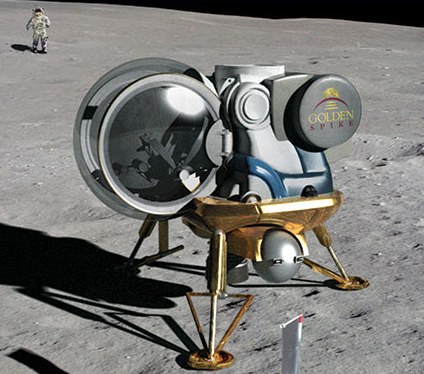
Illustration of a Golden Spike lunar lander. (Credit: Golden Spike)
This morning I posted some things to look for in today’s unveiling of Golden Spike, the company planning commercial human lunar missions as early as 2020. With the company’s Washington press conference now complete, let’s quickly revisit those topics:
Technology: As expected, the company is leveraging existing capabilities in terms of launch vehicles, spacecraft, and the like, focusing on developing only those components that don’t exist today. “Take a look at what you’ve already got in terms of existing assets, use existing launch vehicles, adapt crew capsules that are already in development,” said Alan Stern, president and CEO of Golden Spike. “Only develop new systems, like an expedition lander and surface suits, where no system exists today.” He calls this a “head start” architecture that “offers enormous and convincing cost, schedule, and reliability advantages” over an entirely clean-sheet approach.
Financing: Even with this “head start” approach, the company will still need significant amount of money to develop this system: Stern said they estimate the cost to be $7–8 billion, which is still far less than any other human lunar mission approach. Stern said that while they’ll raise the money though a variety of means, including advance sales of expedition and an “enterprising financing plan,” they’ll still need to raise “hundreds of millions of dollars” from outside investors.
The company declined to go into details about their investment plans, including how much they’ve raised and from whom. “We don’t have any billion-dollar backers,” Stern said. Gerry Griffin, the chairman of the company’s board of directors, addressed “some pretty wild speculation” in the media about who might be funding the company. “For example, I read that Warren Buffett is involved. Let me just say that we’re in an earlier stage of this company than some people may think,” he said. “On the other hand, if any of you know Warren, I’d be grateful if you’d point him my way.”
Business Case: Who would be the customers of the company’s lunar expeditions? Their biggest target is what some in the industry call “sovereign clients”, or national space agencies that don’t have their own human spaceflight programs. “We expect significant demand from foreign space agencies,” Stern said, citing an internal market study that identified 15 to 20 “or more” nations out there that could afford such a mission, which the company prices at $1.5 billion a flight. “We’ve already had conversations with some national space agencies, and they’ve expressed their interest.”
Other markets include individual tourists or companies interested in commercial exploitation of the Moon. Stern said he’s talked with one unnamed individual who is “very seriously” interested in such a trip.
But are those markets big enough to warrant the hundreds of millions of dollars of outside investment, when other ventures, like Google Lunar X PRIZE teams and Space Adventures’ circumlunar flights, have struggled to find customers and line up significantly smaller tranches of funding? Stern and Griffin said that landing people on the Moon is big and exciting enough to attract interest that other ventures haven’t found. “It’s apples and oranges,” said Griffin, calling human spaceflight “a different domain” than robotic landers. “You can’t compare this to the Google Lunar X PRIZE. It’s not the same animal.”
Human missions, said Stern, “will attract a lot more interest, and, unlike a figure-eight flyby around the Moon”—a reference to the Space Adventures proposed mission—“these are serious scientific expeditions, so you don’t have to justify it as a stunt” but instead as science.
Indeed, human missions to the surface of the Moon are far different than anything else proposed to date. Whether they are exciting and compelling enough to open up investors’ pocketbooks and space agencies’ coffers to the tune of several billion dollars is a question whose answer will unfold over the next few years.

Leave a Reply